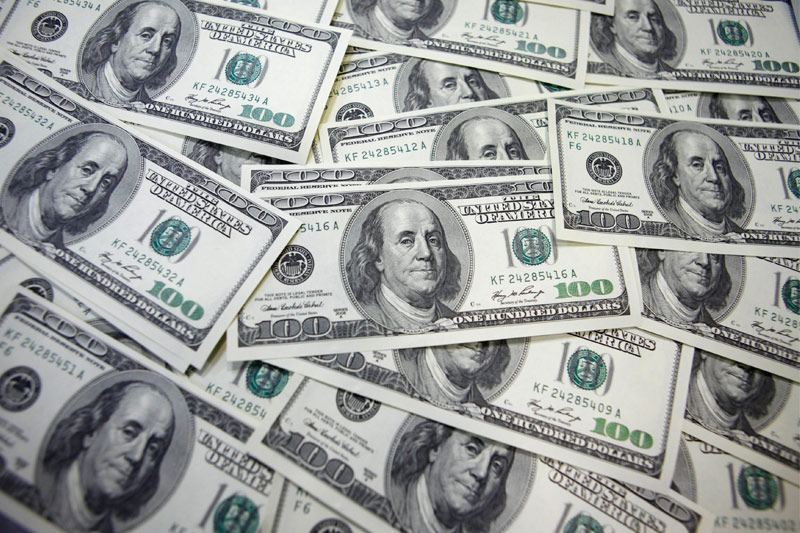Investing.com - The U.S. dollar remained broadly higher against its global counterparts on Wednesday, after better-than-expected employment data from the U.S. further dampened expectations for additional monetary easing while weak euro zone reports continued to weigh.
During European afternoon trade, the dollar was up against the euro, with EUR/USD shedding 0.79% to hit 1.3127.
Payroll processing firm ADP said non-farm private employment rose by a seasonally adjusted 209,000 in March, beating expectations for an increase of 200,000.
The previous month’s figure was revised up to a gain of 230,000 from a previously reported increase of 216,000.
Sentiment on the euro was hit earlier as the cost of insuring Spain’s debt against default climbed earlier after the country auctioned EUR2.59 billon of government bonds, short of the maximum targeted amount of EUR3.5 billion.
The auction came after data confirmed that the euro zone service sector contracted for the sixth time in seven months in March, increasing the likelihood that the economy has entered a technical recession.
Also Wednesday, the European Central Bank left its benchmark interest unchanged at 1.00%, in a widely expected decision.
Meanwhile, a report showed that euro zone retail sales fell by 0.1% in February, against expectations for a 0.1% increase and were 2.1% lower year-on-year.
Earlier in the day, official data showed that German factory orders rose 0.3% in February, below expectations for a 1.2% increase, renewing concerns over the economic outlook for the bloc’s largest economy.
The greenback was slightly higher against the pound, with GBP/USD retreating 0.26% to hit 1.5869.
The pound found support following a report showing that the U.K. service sector expanded more-than-forecast in March, adding to hopes that the economic recovery is gaining traction.
The services PMI rose to 55.3 last month, its highest level since January and up from a reading of 53.8 in February. Economists had forecast a decline to 53.5 last month.
The greenback was lower against the yen but pushed higher against the Swiss franc, with USD/JPY falling 0.52% to hit 82.37 and USD/CHF climbing 0.78% to hit 0.9169.
Elsewhere, the greenback was broadly higher against its Canadian, Australian and New Zealand counterparts, with USD/CAD adding 0.50% to hit 0.9959, AUD/USD dropping 0.60% to hit 1.0271 and NZD/USD falling 0.60% to hit 0.8139.
Sentiment on the Australian dollar was hit after official data showed earlier that the country posted a trade deficit of AUD0.48 billion in February, disappointing expectations for a surplus of AUD1.12 billion and fuelling fears over an economic slowdown.
The dollar index, which tracks the performance of the greenback versus a basket of six other major currencies, rose 0.55% to hit 79.97.
Later in the day, the U.S. was to produce a report by the Institute of Supply Management on service sector activity and government data on crude oil stockpiles.
During European afternoon trade, the dollar was up against the euro, with EUR/USD shedding 0.79% to hit 1.3127.
Payroll processing firm ADP said non-farm private employment rose by a seasonally adjusted 209,000 in March, beating expectations for an increase of 200,000.
The previous month’s figure was revised up to a gain of 230,000 from a previously reported increase of 216,000.
Sentiment on the euro was hit earlier as the cost of insuring Spain’s debt against default climbed earlier after the country auctioned EUR2.59 billon of government bonds, short of the maximum targeted amount of EUR3.5 billion.
The auction came after data confirmed that the euro zone service sector contracted for the sixth time in seven months in March, increasing the likelihood that the economy has entered a technical recession.
Also Wednesday, the European Central Bank left its benchmark interest unchanged at 1.00%, in a widely expected decision.
Meanwhile, a report showed that euro zone retail sales fell by 0.1% in February, against expectations for a 0.1% increase and were 2.1% lower year-on-year.
Earlier in the day, official data showed that German factory orders rose 0.3% in February, below expectations for a 1.2% increase, renewing concerns over the economic outlook for the bloc’s largest economy.
The greenback was slightly higher against the pound, with GBP/USD retreating 0.26% to hit 1.5869.
The pound found support following a report showing that the U.K. service sector expanded more-than-forecast in March, adding to hopes that the economic recovery is gaining traction.
The services PMI rose to 55.3 last month, its highest level since January and up from a reading of 53.8 in February. Economists had forecast a decline to 53.5 last month.
The greenback was lower against the yen but pushed higher against the Swiss franc, with USD/JPY falling 0.52% to hit 82.37 and USD/CHF climbing 0.78% to hit 0.9169.
Elsewhere, the greenback was broadly higher against its Canadian, Australian and New Zealand counterparts, with USD/CAD adding 0.50% to hit 0.9959, AUD/USD dropping 0.60% to hit 1.0271 and NZD/USD falling 0.60% to hit 0.8139.
Sentiment on the Australian dollar was hit after official data showed earlier that the country posted a trade deficit of AUD0.48 billion in February, disappointing expectations for a surplus of AUD1.12 billion and fuelling fears over an economic slowdown.
The dollar index, which tracks the performance of the greenback versus a basket of six other major currencies, rose 0.55% to hit 79.97.
Later in the day, the U.S. was to produce a report by the Institute of Supply Management on service sector activity and government data on crude oil stockpiles.
